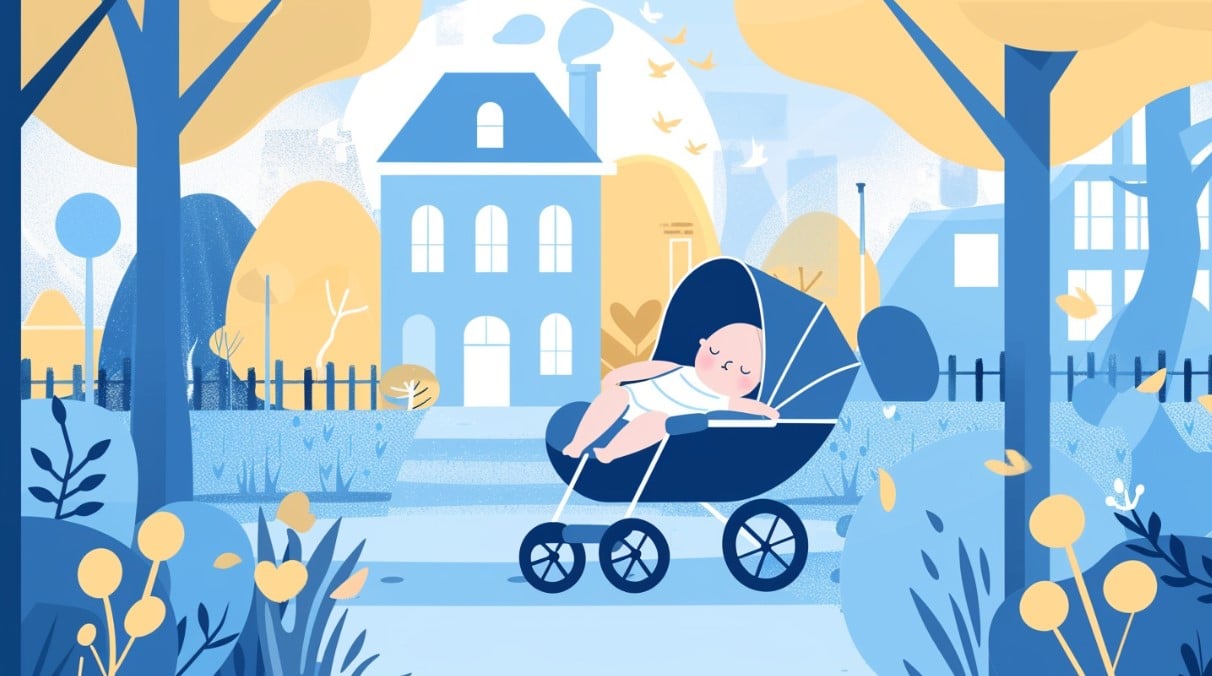In many parts of the world, the idea of letting a baby nap outside, especially during colder months, might seem unusual. But stroll through any Danish town or city, and you'll likely come across a pram, gently rocked by the breeze, with a peacefully sleeping baby inside. This age-old Danish custom of outdoor napping is more than just a unique local practice—it's a window into the cultural values and beliefs of Denmark.
This tradition, deeply ingrained and widely practiced, offers an intriguing blend of history, health, and community that many foreigners in Denmark find fascinating. As we delve deeper into why babies sleep outside in Denmark, we'll uncover the richness of Danish culture and the importance of nature in the everyday lives of its people.
Key Takeaways
- Outdoor napping for babies is deeply rooted in Danish culture and history.
- Fresh air ("frisk luft") is seen as essential for mental and physical well-being in Denmark.
- The practice promotes resilience by gently exposing babies to the elements.
- Practical benefits include improved sleep quality, natural acclimatization, and reduced exposure to indoor pollutants.
- Safety and monitoring are paramount in the practice, emphasizing the community's trust and mutual responsibility.
- The tradition carries significant cultural weight, symbolizing Danish values like closeness to nature, trust, and resilience.
Why Babies Sleep Outside in Denmark
The origins of babies napping outside in Denmark can be traced back to the early 20th century. During this period, Europe was undergoing significant shifts in its understanding of health and well-being. In many Scandinavian countries, including Denmark, a movement emerged that emphasized the revitalizing qualities of fresh air. This movement wasn't limited to just adults. Children, especially the youngest members of society, were believed to benefit immensely from consistent exposure to the outdoors.
Medical professionals and health advocates of the time widely promoted the idea that fresh air played a pivotal role in preventing diseases. In Denmark, this perspective quickly took root. As urbanization progressed and cities became more crowded, the contrasting purity of outdoor air became even more cherished. Parents were advised to let their children, including infants, spend a significant amount of time outdoors. This was seen as a proactive approach to safeguarding their health and ensuring robust physical development.
Outdoor kindergartens, known as "forest kindergartens," also began to gain popularity during this era. These schools operated primarily outside, allowing children to play, learn, and even nap in nature's embrace. The success of these kindergartens further reinforced the belief in the health benefits of outdoor living for children.
Beliefs and Reasons Behind the Practice
At the heart of Denmark's outdoor napping tradition lies a profound appreciation for nature and the holistic well-being it offers. While to outsiders, it might simply appear as a quaint or peculiar practice, the reasons for letting babies sleep outdoors are deeply rooted in Danish cultural beliefs and perceptions of health.

The Fresh Air Philosophy
The Danes have a longstanding belief in the invigorating properties of fresh air. Known as "frisk luft" in Danish, fresh air is often considered an elixir for both the mind and body. The concept isn't just about the absence of pollutants; it embodies the essence of nature—crisp, rejuvenating, and pure.
This perspective aligns with the Danish love for the outdoors, be it cycling, hiking, or simply enjoying a picnic in a local park. Therefore, it's only natural that they'd want their youngest to start absorbing these benefits right from infancy.
Building Resilience from a Tender Age
Another underlying belief is the idea of 'hardening' or building resilience. Danes believe that by giving babies controlled exposure to the elements, they are fostering a sense of toughness and adaptability. This doesn't mean exposing the child to harsh or extreme conditions, but rather allowing them to experience and adapt to the varying atmospheres of the Danish climate.
This gentle acclimatization is seen as a foundational step in building a resilient constitution.
Association with Good Health
Over time, the practice has also been associated with tangible health benefits. Many parents and even pediatricians in Denmark observe that children who spend more time outdoors, including napping, tend to fall ill less often.
The belief is that the fresh air boosts their immune systems, making them more resistant to common ailments. Moreover, the consistent rhythm of outdoor napping is thought to promote better sleep cycles and overall restfulness.
Nature as a Soothing Element
Lastly, there's a widespread belief in the calming and soothing properties of nature. The gentle rustling of leaves, the distant chirping of birds, and the rhythmic patterns of natural sounds are seen as natural lullabies. These subtle symphonies of nature are believed to offer a more serene and calming environment for babies to rest than the often unpredictable noises of indoor settings.
Practical Benefits
Beyond cultural beliefs and traditional values, the practice of letting babies sleep outside in Denmark is supported by a range of practical benefits observed by parents, caregivers, and even researchers. These advantages reinforce the reasons many Danish families continue to embrace outdoor napping.
Enhanced Sleep Quality
One of the most commonly cited benefits is the improvement in sleep quality. Parents often report that babies who nap outdoors tend to sleep more deeply and for longer durations. The natural ambient noises, combined with fresh air, seem to induce a more restful sleep. This can be particularly beneficial for babies who might be restless sleepers indoors.
Natural Acclimatization
Outdoor napping introduces babies to the rhythm of the natural environment. Over time, babies become more accustomed to the fluctuations of the Danish climate. This acclimatization is not just about weather; it's also about the day-to-night cycle. Regular exposure to natural light during nap times can help regulate a baby's internal clock, promoting better sleep patterns and potentially reducing sleep disruptions as they grow.
Stimulating Sensory Development
The outdoor environment is rich in stimuli. Even when a baby is asleep, the subtle sounds of nature, the feel of the breeze, and the scents of the outdoors can engage their senses.
This gentle sensory stimulation is believed to aid in their overall sensory development. It exposes them to a variety of natural cues, subtly enhancing their awareness of the world around them.
Mental and Emotional Well-being
Though hard to quantify, there's a belief that outdoor napping contributes to a baby's mental and emotional well-being. The calming influence of nature, combined with the consistent routine of outdoor naps, might play a role in fostering a sense of security and tranquility in babies.
Reduced Exposure to Indoor Pollutants
Indoor environments, despite seeming clean, can sometimes harbor pollutants like dust mites, mold, or pet dander. Letting babies nap outdoors reduces their exposure to such potential allergens, offering them a cleaner breathing space, which can be particularly beneficial for their developing respiratory systems.
Safety and Precautions
As intriguing as the tradition of outdoor napping might sound, it's essential to understand that Danish parents prioritize the safety and comfort of their babies above all else. While the practice has deep cultural roots and numerous benefits, it's carried out with meticulous care and a set of precautions to ensure the baby's well-being.
| Precautionary Measure | Description |
| Dressing for the Weather | Babies are layered in breathable materials, adjusting to seasonal requirements. |
| Protected Sleeping Environment | Prams designed for varied climate, offering protection from sunlight, wind, and rain. |
| Monitoring the Baby | Regular checks ensure the baby's comfort, with parents maintaining a close watch. |
| Communal Watchfulness | An unspoken societal norm where the community looks out for napping babies in public spaces. |
| Awareness of Surroundings | Selection of safe, calm, and unpolluted spots for napping, away from traffic and excessive noise. |
Dressing for the Weather
The first and foremost consideration is ensuring that the baby is appropriately dressed. Danish parents are experts at layering. Babies are often dressed in breathable wool or other insulating materials, which keep them warm without causing overheating. Depending on the season, they might add mittens, hats, and thermal socks. In colder months, babies are snugly wrapped in blankets or sleeping bags specifically designed for outdoor use.
Protected Sleeping Environment
The prams or baby carriages used in Denmark for outdoor napping are not ordinary. They're often designed with the country's variable climate in mind. These prams come with canopies and covers that shield the baby from direct sunlight, wind, and even light rain. They also have well-ventilated designs, ensuring a steady flow of fresh air while protecting from external elements.
Monitoring the Baby
Even though the baby might be outside, they're never left unsupervised for extended periods. Parents often check on their napping child regularly, ensuring that they remain comfortable. If the baby is outside a cafe or a shop, the parents usually sit near a window or a vantage point where they can keep an eye on the pram.
Communal Watchfulness
In Denmark, there exists an unspoken sense of community responsibility. In residential neighborhoods or local cafes, it's not uncommon for neighbors, friends, or even strangers to cast a protective glance over a napping baby. This communal watchfulness exemplifies the strong community bonds and shared values in Danish society.
Awareness of Surroundings
Parents ensure that the chosen spot for outdoor napping is safe. They avoid places with excessive noise, pollution, or those too close to traffic. The idea is to provide a peaceful and secure environment that's conducive to a baby's rest.
Cultural Significance
To truly grasp the essence of babies napping outdoors in Denmark, one must understand its cultural significance within the fabric of Danish society. The practice isn’t merely a matter of health or convenience; it symbolizes broader cultural ideologies and values that the Danes hold dear.
Nature and Well-being
Denmark’s relationship with nature has always been intimate. The country's flat landscapes, coastal regions, and dense forests have historically shaped the lives of its people.
The Danes have always believed in the harmony of living close to nature. This connection to the natural world extends to their approach to child-rearing, where nature isn't seen as a separate entity but an integral part of holistic well-being.
Trust and Security
Allowing babies to nap outdoors in public spaces also speaks volumes about the trust and security that Danish society cherishes. In many parts of the world, leaving a child outside a cafe or home would be unthinkable.
But in Denmark, there's an inherent trust in the community and a mutual respect for personal boundaries. This showcases the communal bonds and the collective responsibility the Danes feel towards each other.
Simplicity and Authenticity
The Danish principle of 'hygge', which loosely translates to 'coziness' or 'comfort', is about cherishing simple pleasures and authentic experiences. Outdoor napping is a manifestation of this principle. Instead of high-tech baby monitors or specialized indoor sleeping gadgets, the simple act of letting a baby sleep outdoors, cradled by nature, exemplifies the Danish pursuit of genuine, unadulterated joy.
Teaching Resilience
By introducing babies to the elements early on, the Danes are also instilling a lesson in resilience. They believe in preparing their young for the world, not by sheltering them but by gently exposing them to life's variabilities. This early lesson is a reflection of the broader Danish ethos that values strength, adaptability, and a pragmatic approach to challenges.
Related: New to Denmark: Complete English Guide (2024)
Comparison to Other Countries
The practice of letting babies nap outdoors might seem particularly distinct to Denmark, but it's worth noting that Denmark isn't alone in this tradition. A glimpse at the child-rearing customs across different countries offers an interesting perspective on the diverse approaches to infant care.
Nordic Neighbors
Denmark's Nordic neighbors, like Norway, Sweden, and Finland, also share the outdoor napping tradition. In these countries, it's not uncommon to see rows of prams lined outside homes, daycare centers, or cafes, with babies bundled up and enjoying their outdoor siestas. The reasons, similar to Denmark, range from health benefits to cultural values emphasizing resilience and a connection to nature.
Contrast with Mediterranean Countries
In contrast, countries in the Mediterranean, such as Spain or Italy, have a different relationship with outdoor naps for babies. While these nations value afternoon siestas and the benefits of rest, babies typically nap indoors, shielded from the often intense sun and heat. The emphasis here is more on the family unit's warmth and intimacy rather than the direct engagement with the outdoors.
Asia's Indoor Preference
In many Asian countries, like Japan, China, or India, babies predominantly sleep indoors. Cultural and climatic factors play a role in this preference. The densely populated urban areas, combined with weather extremities in some regions, often make outdoor napping less practical. Moreover, multi-generational living is common in these countries, and the indoor environment provides a collective space for family members to oversee the baby's care closely.
North American Views
In North America, outdoor napping isn't a widespread practice. Concerns around safety, combined with varying weather conditions and a more individualistic societal structure, have influenced this indoor preference. However, the idea of children spending quality time outdoors is still valued, as seen in the popularity of summer camps or backyard play.
Adaptations and Evolutions
While Denmark and its Nordic counterparts might stand out for their outdoor napping tradition, it's essential to realize that each country's infant care practices are shaped by a complex interplay of history, climate, societal structures, and cultural beliefs. What might be normative in one nation could seem peculiar in another, but each practice offers unique insights into the values and priorities of societies worldwide.






